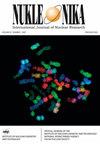Clinical advantages of using unflattened 6-MV and 10-MV photon beams generated by the medical accelerator Elekta Versa HD based on their dosimetric parameters in comparison to conventional beams
IF 0.3
4区 物理与天体物理
Q4 CHEMISTRY, INORGANIC & NUCLEAR
引用次数: 8
Abstract
Abstract Photon beams with wide energy ranges from 4 MV to 25 MV are commonly used in radiotherapy nowadays. In recent years, there has been a strong interest in a certain modification of a radiotherapeutic apparatus by the application of the so-called flattening filter-free (FFF) beam. Several advantages of FFF beams over standard flattening filter (FF) beams are noticed, and this technical solution has aroused great interest among radiotherapeutic facilities. The goal of the present study is to investigate the differences between the conventional FF and unflattened FFF 6-MV and 10-MV photon beams in some basic dosimetric parameters and their influence on the whole radiotherapeutic treatment. The data provided here include the detailed characteristics as follows: percent depth dose (PDD), beam profile, edge of a half-profile, total scatter correction factor (TSCF) and head scatter correction factor (HSCF) for FF and FFF 6-MV and 10-MV photon beams from the Elekta Versa HD accelerator in the Katowice Oncology Center in Poland.医用加速器Elekta Versa HD产生的非扁平6 mv和10 mv光子束的剂量学参数与常规光束的临床优势
摘要光子束的能量范围很宽,从4MV到25MV,目前广泛用于放射治疗。近年来,人们对通过应用所谓的无平坦滤波器(FFF)波束对放射治疗设备进行某种修改产生了强烈的兴趣。FFF波束相对于标准平坦滤波器(FF)波束的几个优点被注意到,并且该技术解决方案在放射治疗设备中引起了极大的兴趣。本研究的目的是研究常规FF和未衰减FFF 6-MV和10-MV光子束在一些基本剂量测定参数方面的差异及其对整个放射治疗的影响。这里提供的数据包括以下详细特征:波兰卡托维兹肿瘤中心Elekta Versa HD加速器的FF和FFF 6-MV和10-MV光子束的深度剂量百分比(PDD)、光束轮廓、半轮廓边缘、总散射校正因子(TSCF)和头部散射校正因子。
本文章由计算机程序翻译,如有差异,请以英文原文为准。
求助全文
约1分钟内获得全文
求助全文
来源期刊

Nukleonika
物理-无机化学与核化学
CiteScore
2.00
自引率
0.00%
发文量
5
审稿时长
4-8 weeks
期刊介绍:
"Nukleonika" is an international peer-reviewed, scientific journal publishing original top quality papers on fundamental, experimental, applied and theoretical aspects of nuclear sciences.
The fields of research include:
radiochemistry, radiation measurements, application of radionuclides in various branches of science and technology, chemistry of f-block elements, radiation chemistry, radiation physics, activation analysis, nuclear medicine, radiobiology, radiation safety, nuclear industrial electronics, environmental protection, radioactive wastes, nuclear technologies in material and process engineering, radioisotope diagnostic methods of engineering objects, nuclear physics, nuclear reactors and nuclear power, reactor physics, nuclear safety, fuel cycle, reactor calculations, nuclear chemical engineering, nuclear fusion, plasma physics etc.
 求助内容:
求助内容: 应助结果提醒方式:
应助结果提醒方式:


